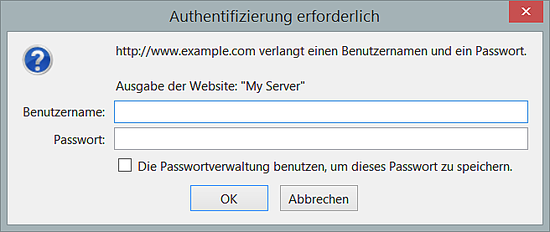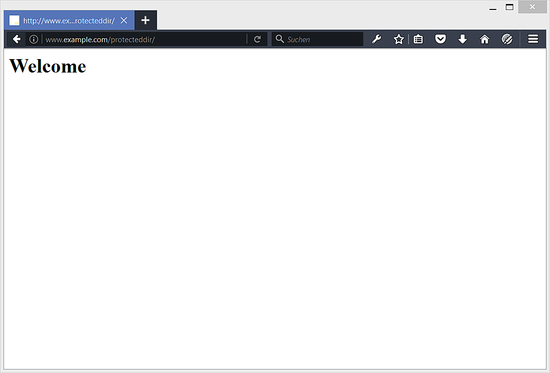本指南介绍如何使用Debian 8(Jessie)服务器上Apache2上的mod_authn_dbd密码保护网络目录(与MySQL数据库中的用户)。 它是由mod_auth提供的纯文本密码文件的替代,并允许您使用普通的SQL语法来创建/修改删除用户。 您还可以配置mod_authn_dbd来对现有的MySQL用户表进行身份验证。 apache mod_authn_dbd是mod_auth_mysql的替代品。
1初步说明
我在这里使用vhost http://www.example.com的vhost配置文件/etc/apache2/sites-available/example.com.vhost和文档根/var/www/www.example.com/web 。 我想在本教程中密码保护目录/var/www/example.com/web/protecteddir (转换为http://www.example.com/protecteddir/ )。
如果您还没有安装Apache,可以使用本教程的基本LAMP服务器 。
2安装MySQL或MariaDB
我将使用MariaDB,这里是MySQL fork,而不是MySQL。 但是,如果你喜欢MySQL,MySQL也是如此。 要安装MariaDB,我们运行:
apt-get -y install mariadb-server mariadb-client
您将被要求为MySQL root用户提供密码:
MariaDB“root”用户的新密码: < - yourrootsqlpassword
重复使用MariaDB“root”用户的密码: < - yourrootsqlpassword
安装DBD MySQL模块:
apt-get install libaprutil1-dbd-mysql
然后,启用mod_authn_dbd模块:
a2enmod dbd
a2enmod authn_dbd
authn_socache
重新启动Apache:
service apache2 restart
3配置mod_authn_dbd
您可以在Apache文档http://httpd.apache.org/docs/current/mod/mod_authn_dbd.html中找到mod_authn_dbd的文档 。
读取这两个文件后,我们创建一个名为examplecomdb的MySQL数据库,我们将在其中创建包含我们的用户和密码的表mysql_auth。 除此之外,我们创建了MySQL用户examplecom_admin - 该用户将被mod_auth_mysql用于以下连接到MySQL:
mysqladmin -u root -p create examplecomdb
mysql -u root -p
GRANT SELECT, INSERT, UPDATE, DELETE ON examplecomdb.* TO 'examplecom_admin'@'localhost' IDENTIFIED BY 'examplecom_admin_password';
GRANT SELECT, INSERT, UPDATE, DELETE ON examplecomdb.* TO 'examplecom_admin'@'localhost.localdomain' IDENTIFIED BY 'examplecom_admin_password';
FLUSH PRIVILEGES;
(用您选择的密码替换examplecom_admin_password 。)
USE examplecomdb;
create table mysql_auth (
username varchar(255) not null,
passwd varchar(255),
groups varchar(255),
primary key (username)
);
(当然,您也可以使用包含用户凭据的现有表,并且还可以在表中添加其他字段,例如定义用户是否处于活动状态的字段)。
现在我们将用户测试插入我们的mysql_auth表,密码测试 ; 该用户属于组测试组。
密码必须被哈希,我将在这里使用一个SHA1哈希哈希可以使用htpasswd命令在Linux shell上创建:
htpasswd -bns test test
结果是这样的:
test:{SHA}qUqP5cyxm6YcTAhz05Hph5gvu9M=
第一部分是用户名“test”,用“:”分隔,然后是散列的密码。 我们需要散列密码“{SHA} qUqP5cyxm6YcTAhz05Hph5gvu9M =”仅将其插入到我们的用户数据库中。 MySQL查询是这样的:
INSERT INTO `mysql_auth` (`username`, `passwd`, `groups`) VALUES('test', '{SHA}qUqP5cyxm6YcTAhz05Hph5gvu9M=', 'testgroup');
然后我们离开MySQL shell:
quit
要将mod_authn_dbd的配置包含在vhost文件中,可能不会在.htaccess文件中添加。 因此,我们编辑vhost文件,并在文件末尾添加以下配置 :
nano /etc/apache2/sites-available/example.com.vhost
[...] # mod_dbd configuration
DBDriver mysql
DBDParams "dbname=examplecomdb user=examplecom_admin pass=examplecom_admin_password"
DBDMin 4
DBDKeep 8
DBDMax 20
DBDExptime 300
<Directory "/var/www/example.com/web/protecteddir">
# mod_authn_core and mod_auth_basic configuration
# for mod_authn_dbd
AuthType Basic
AuthName "My Server"
# To cache credentials, put socache ahead of dbd here
AuthBasicProvider socache dbd
# Also required for caching: tell the cache to cache dbd lookups!
AuthnCacheProvideFor dbd
AuthnCacheContext my-server
# mod_authz_core configuration
Require valid-user
# mod_authn_dbd SQL query to authenticate a user
AuthDBDUserPWQuery "SELECT passwd FROM mysql_auth WHERE username = %s"
</Directory>
重新加载Apache:
service apache2 reload
如果您的MySQL表中有其他字段可以定义是否允许用户登录(例如,一个称为活动的用户 ),则可以将其添加到SQL用户查询中,如下所示:
[...] AuthDBDUserPWQuery "SELECT passwd FROM mysql_auth WHERE username = %s and active = 'yes'" [...]
require valid-user指令使mysql_auth表中列出的每个用户都可以登录,只要他/她提供正确的密码。 如果您只希望允许某些用户登录,您可以使用类似的东西
[...] require user jane joe [...]
代替。 如果您只希望某些群组的成员被允许登录,则可以使用以下内容:
[...] require group testgroup [...]
而已! 现在尝试访问http://www.example.com/protecteddir/ ,您将被要求输入用户名和密码:


4链接
- Apache: http : //httpd.apache.org/
- Debian: http : //www.debian.org/
- mod_authn_dbd: http : //httpd.apache.org/docs/current/mod/mod_authn_dbd.html








